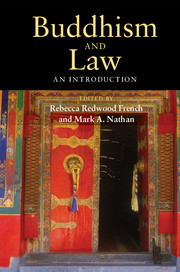Book contents
- Frontmatter
- Dedication
- Contents
- Maps and Illustrations
- Contributors
- Preface
- Abbreviations
- Introducing Buddhism and Law
- Part I The Roots of Buddhism and Law in India
- 1 Society at the Time of the Buddha
- 2 What the Vinayas Can Tell Us about Law
- 3 Keeping the Buddha’s Rules
- 4 Proper Possessions
- 5 On the Legal and Economic Activities of Buddhist Nuns
- Part II Buddhism and Law in South and Southeast Asia
- Part III Buddhism and Law in East Asia
- Part IV Buddhism and Law in North Asia and the Himalayan Region
- A Selection of Readings
- Index
- References
4 - Proper Possessions
Buddhist Attitudes toward Material Property
Published online by Cambridge University Press: 05 August 2014
- Frontmatter
- Dedication
- Contents
- Maps and Illustrations
- Contributors
- Preface
- Abbreviations
- Introducing Buddhism and Law
- Part I The Roots of Buddhism and Law in India
- 1 Society at the Time of the Buddha
- 2 What the Vinayas Can Tell Us about Law
- 3 Keeping the Buddha’s Rules
- 4 Proper Possessions
- 5 On the Legal and Economic Activities of Buddhist Nuns
- Part II Buddhism and Law in South and Southeast Asia
- Part III Buddhism and Law in East Asia
- Part IV Buddhism and Law in North Asia and the Himalayan Region
- A Selection of Readings
- Index
- References
Summary
“House life is crowded and dusty; going forth is wide open. It is not easy, living life in a household, to lead a holy life as utterly perfect as a polished shell. Suppose I were to shave off my hair and beard, put on saffron garments, and go forth from home into homelessness?”
– Majjhima Nikāya I.240“[A]mong all the religions of India it went furthest in declaring the illusory nature of the world and individual self, and the necessity for salvation through detachment.”
– Stanley J. TambiahIntroduction
It is one of the distinctive features of the Buddhist tradition that the Buddha’s life story serves as what can be understood to be, with a nod to Clifford Geertz, both a model of the ideal Buddhist life and a model for all Buddhists to follow. In other words, the Buddha’s life is both descriptive of and prescriptive for the proper Buddhist life. At the heart of this story is the young prince’s decision to abandon his wife and child, his parents, and the kingdom he is to inherit, in order to seek the enlightenment that will alleviate the suffering that is inherent in the human condition. He goes forth from home to homelessness – anāgāriya in Pāli – and becomes an ascetic without attachment to people, places, or things. “Homelessness,” thus, denotes more than the literal state of being without a home in Buddhism, but serves as a kind of synecdochic marker for the monastic life. The life of the monk is, fundamentally, described in Pāli canonical texts as the life of an ascetic, devoid of all worldly attachments and property, because such things engender grasping, which is the underlying cause of all suffering.
- Type
- Chapter
- Information
- Buddhism and LawAn Introduction, pp. 78 - 90Publisher: Cambridge University PressPrint publication year: 2014
References
- 1
- Cited by



